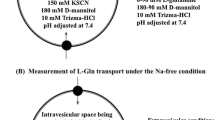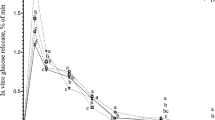Abstract
Although the neonatal intestine is able to process milk and absorb the components, problems of digestion are common. Because of the limited availability of human fetal and neonatal tissues, relatively little is known about functional development of the intestine, particularly during the third trimester when premature births and digestive insufficiencies are likely. Because pigs share with humans similar digestive system structure and functions, we characterized development of hydrolytic and transport activities in pigs, using brush border membrane vesicles (BBMV) and intact tissues prepared from 7, 8, 10 and 12 wk fetuses (43, 49, 61 and 74% of term, respectively), unsuckled neonates and during the first 24 hr of suckling. Intestinal weight increased exponentially between 7 and 12 wk of gestation, more than 7 fold between 12 wk and birth and nearly 2 fold after 24 hr of suckling. Lactase was detected at 7 wk, activity increased dramatically between 10 wk and birth and established a proximal to distal gradient, with a further increase after birth. Sucrase was not detected prenatally, with only low activity during the perinatal period. Active L-leucine uptake was detected at 7 wk, with a decreasing proximal to distal gradient present at birth. D-glucose uptake at 7 wk was low and mostly Na+ independent but a typical overshoot phenomenon was present at 8 wk. At 12 wk and birth, D-glucose uptake was strictly Na+ dependent along the entire length of intestine; it declined from proximal to distal. Kinetic analysis of uptake concentration data revealed the presence of both high and low affinity systems at 8 wk of gestation but only a single high affinity Michaelian system at birth and thereafter. The appearance of hydrolytic and transport functions during early gestation of pigs, and the switch in transport systems, is similar to reports for humans. Therefore, the pig may be a valuable model for studying prenatal and perinatal intestinal development and should provide much needed insights about the final trimester of pregnancy.
Access this chapter
Tax calculation will be finalised at checkout
Purchases are for personal use only
Preview
Unable to display preview. Download preview PDF.
Similar content being viewed by others
References
Moughan, P.J., Birtles, M.J., Cranwell, P.D., Smith, W.C., and Pedraza, M., 1992, The piglet as a model animal for studying aspects of digestion and absorption in milk-fed human infants, World Rev. Nutr. Diet. 67:40–113.
Shulman, R. J., Henning, S.J., and Nichols, B.L., 1988, The miniature pig as an animal model for the study of intestinal enzyme development, Pediatr. Res. 23:311–315.
Buddington, R.K., and Malo, C., 1995, Intestinal brush-border membrane enzyme activities and transport functions during prenatal development of pigs, J. Pediatr. Gastroenterol. Nutr. 23: 51–64.
Zhang, H., Malo, C., and Buddington, R.K., 1996, Suckling induces rapid intestinal growth and changes in brush border digestive functions of newborn pigs, J. Nutr. In Press.
Butt, J.H., and Wilson, T.H., 1968, Development of sugar and amino acid transport by intestine and yolk sac of the guinea pig, Am. J. Physiol. 215:1468–1477.
Menard, D., 1989, Growth-promoting factors and the development of the human gut, in: Human Gastrointestinal Development, (E. Lebenthal, ed.), Raven Press, New York, pp. 123–150.
Buddington, R.K., 1994, Nutrition and ontogenetic development of the intestine, Can. J. Physiol. Pharmacol. 72:251–259.
Aynsley-Green, A., Lucas, A., Lawson, G.R., and Bloom, S.R., 1990, Gut hormones and regulatory peptides in relation to enteral feeding, gastroenteritis, and necrotizing enterocolitis in infancy, J. Pediatr. 117:S24–S32.
Buddington, R.K., and Diamond, J.M., 1989, Ontogenic development of intestinal nutrient transporters, Annu. Rev. Physiol. 51:601–619.
Malo, C., and Berteloot, A., 1991, Analysis of kinetic data in transport studies: new insights from kinetic studies of Na+-D-Glucose cotransport in human intestinal brush-border membrane vesicles using a fast sampling, rapid filtration apparatus, J. Memb. Biol. 122:127–141.
Mulvihill, S.J., Stone, M.M., Debas, H.T., and Fonkalsrud, E.W., 1985, The role of amniotic fluid in fetal nutrition, J. Ped. Surg. 20:668–672.
Wing, S.J., Trahair, J.F., and Sangild, P., 1994, The effects of various enteral diets on the development of the gastrointestinal tract of the fetal pig, Proc. Aust. Soc. Med. Res. (Abstr.).
Phillips, J.D., Fonkalsrud, E.W., and Mirzayan, A., 1991, Uptake and distribution of continuously infused intraamniotic nutrients in fetal rabbits, J. Pediatr. Surg. 26:374–380.
Pitkin, R.M., and Reynolds, W.A., 1975, Fetal ingestion and metabolism of amniotic fluid protein, Am. J. Obstetr. Gynecol. 123:356–363.
Berseth, C.L., 1990, Neonatal small intestinal motility: motor responses to feeding in term and preterm infants, J. Pediatr. 117:777–782.
Crissinger, K.D., and Burney, D.L., 1991, Postprandial hemodynamics and oxygenation in develo** piglet intestine, Am. J. Physiol. 260:G951–G957.
Lucas, A., 1988, Gut hormones and the adaptation to extrauterine nutrition, in: Harries Paediatric Gastroenterology, (P.J. Milla, and D.P.R. Muller, eds.), Churchill Livingstone, New York, pp 302–317.
Xu, R.-J., Mellor, D.J., Tungthanathanich, P., Birtles, M.J., Reynolds, G.W., and Simpson, H.V., 1992, Growth and morphological changes in the small and large intestine in piglets during the first three days after birth, J. Dev. Physiol 18:161–172.
Cranwell, P.O., 1994, Chapter 5, The development of the neonatal gut and enzyme systems, in: The Neonatal Pig: Development and Survival, (M.A. Varley, ed.), Centre for Agriculture and Biosciences (CAB) Int., Wallingford, Oxford, pp. 52–62.
Burrin, D.G., Shulman, R.J., Reeds, P.J., Davis, T.A., and Gravitt, K.R., 1992, Porcine colostrum and milk stimulate visceral organ and skeletal muscle protein synthesis in neonatal piglets, J. Nutr. 122:1205–1213.
Patureau-Mirand, P., Mosoni, L., Levieux, D., Attaix, D., and Bonnet, Y., 1990, Effect of colostrum feeding on protein metabolism in the small intestine of newborn lambs, Biol. Neonate 57:30–36.
Simmen, F.A., Cera, K.R., and Mahan, D.C., 1990, Stimulation by colostrum or mature milk of gastrointestinal tissue development in newborn pigs, J. Anim. Sci. 68:3596–3603.
Reinhart, G.A., Simmen, F.A., Mahan, D.C., Simmen, R.C.M., White, M.E., and Trulzsch, D.V., 1992, Perinatal ontogeny of fatty acid binding protein activity in porcine small intestine, Nutr. Res. 12:1345–1356.
Kelly, D., McFadyen, M. King, T.P., and Morgan, P.J., 1992, Characterization and autoradiographic localization of the epidermal growth factor receptor in the jejunum of neonatal and weaned pigs, Reprod. Fertil.Dev. 4:183–191.
Smith, M.W., 1988, Postnatal development of transport function in the pig intestine, Comp. Biochem. Physiol. 90A:577–582.
Omodeo-Sale, F., Lindi, C., Marciani, P., Cavatorta, P., Sartor, G., Masotti, L., and Esposito, G., 1991, Postnatal maturation of rat intestinal membrane: lipid composition and fluidity, Comp. Biochem. Physiol. 100A:301–307.
LeGrimellec, C., Friedlander, G., El Yandouzi, E.H., Zlatkine, P., and Giocondi, M.-C., 1992, Membrane fluidity and transport properties in epithelia, Kidney Int. 42:825–836.
Burrin, D.G., Dudley, M.A., Reed, P.J., Shulman, R.J., Perkinson, S., and Rosenberger, J., 1994, Feeding colostrum rapidly alters enzymatic activity and the relative isoform abundance of jejunal lactase in neonatal pigs, J. Nutr. 124:2350–2357.
Schultz, R.D., Wang, J.T., and Dunne, H.W., 1971, Development of the humoral immune response of the pig, Am. J. Vet. Res. 32:1331–1336.
Solomon, J.B., 1971, Foetal and Neonatal Immunology, North Holland Pub. Co., Amsterdam, 41 pp.
Vega-Lopez, M.A., 1991, Immune development in the young pig, PhD Dissertation, University of Bristol, 257 pp.
Weaver, L.T., and Walker, W.A., 1989, Uptake of macromolecules in the neonate, in: Human Gastrointestinal Development, (E. Lebenthal, ed.), Raven Press, New York, pp. 731–748.
Goodman, L.J., 1993, Diagnosis, management, and prevention of diarrheal diseases, Curr. Opin. Inf. Dis. 12:88–93.
Gorbach, S.L., and Goldin, B.R., 1990, The intestinal microflora and the colon cancer connection, Rev. Inf. Dis. 12:S252–S261.
Swords, W.E., Wu, C.-C., Champlin, F.R., and Buddington, R.K., 1993, Postnatal changes in selected bacterial groups of the pig colonic microflora, Biol. Neonate 63:191–200.
Perman, J.A., 1989, Gastrointestinal flora: development aspects and effects of nutrients, in: Human Gastrointestinal Development, (E. Lebenthal, ed.), Raven Press, New York, pp. 777–786.
Author information
Authors and Affiliations
Editor information
Editors and Affiliations
Rights and permissions
Copyright information
© 1996 Springer Science+Business Media New York
About this chapter
Cite this chapter
Buddington, R.K., Malo, C., Zhang, H. (1996). Prenatal and Perinatal Development of Intestinal Transport and Brush Border Hydrolases in Pigs. In: Tumbleson, M.E., Schook, L.B. (eds) Advances in Swine in Biomedical Research. Springer, Boston, MA. https://doi.org/10.1007/978-1-4615-5885-9_30
Download citation
DOI: https://doi.org/10.1007/978-1-4615-5885-9_30
Publisher Name: Springer, Boston, MA
Print ISBN: 978-1-4613-7699-6
Online ISBN: 978-1-4615-5885-9
eBook Packages: Springer Book Archive




